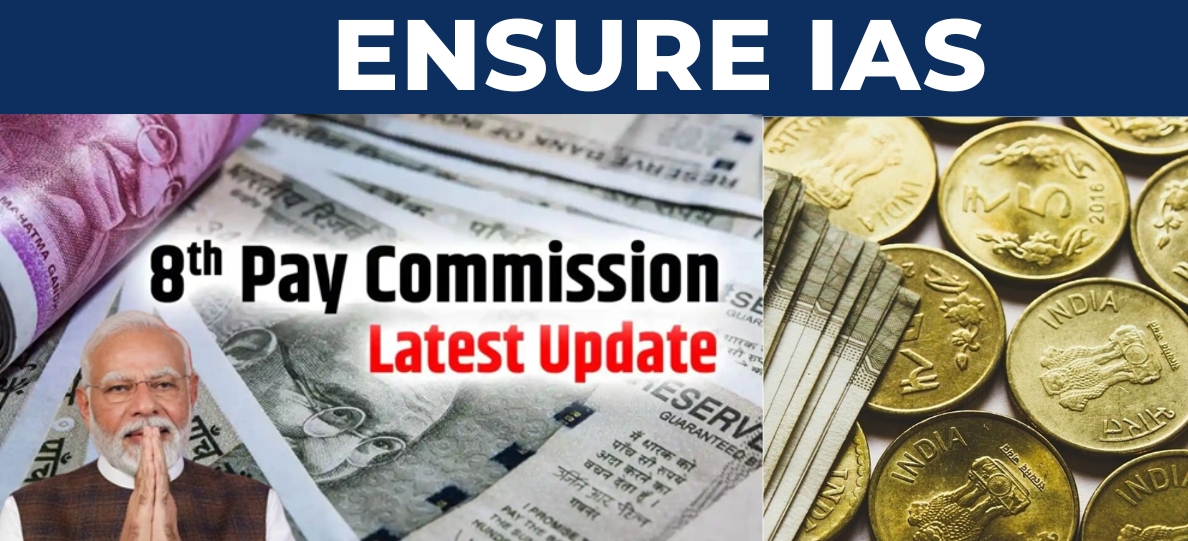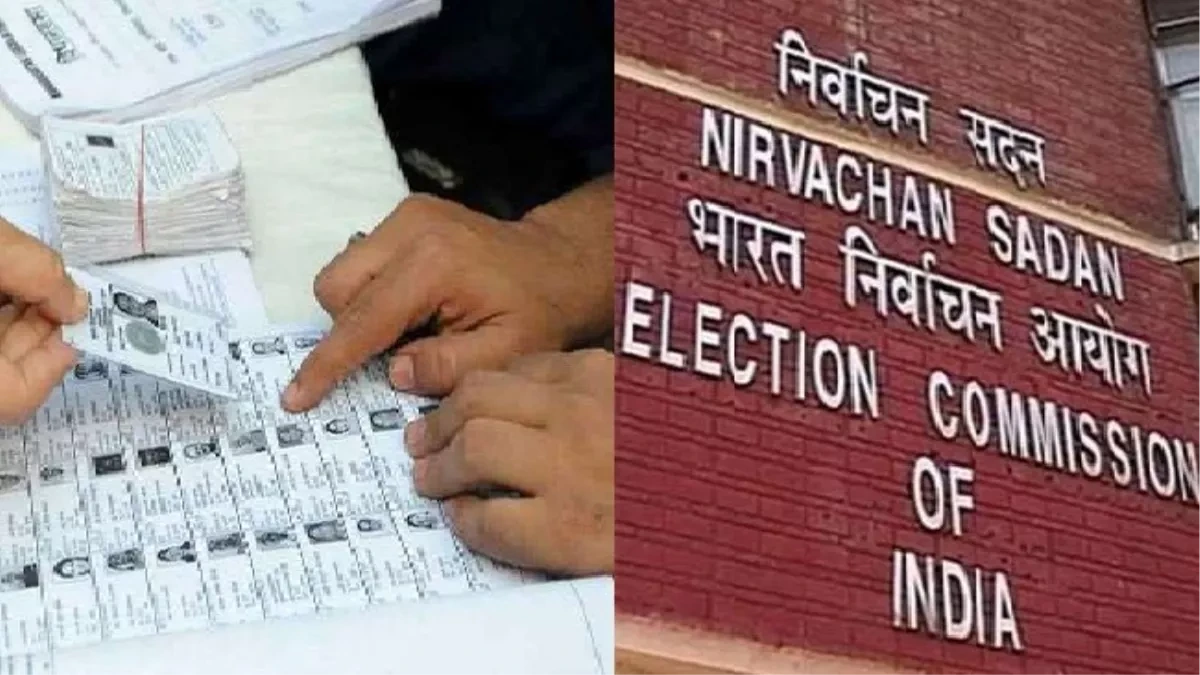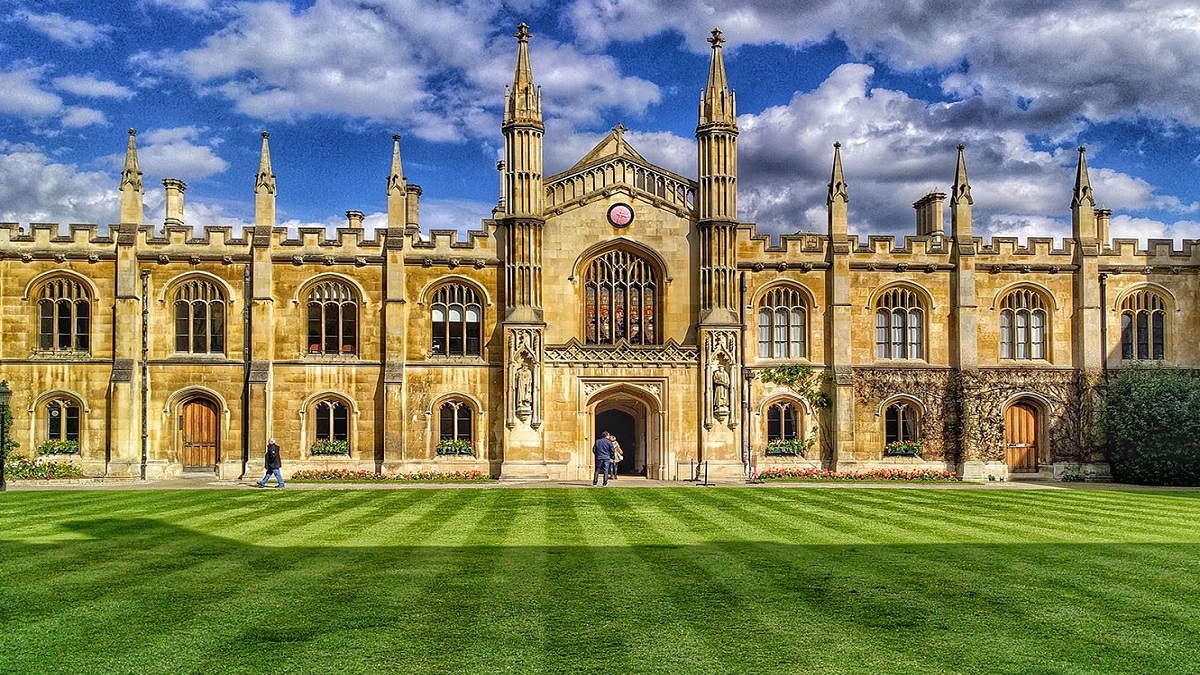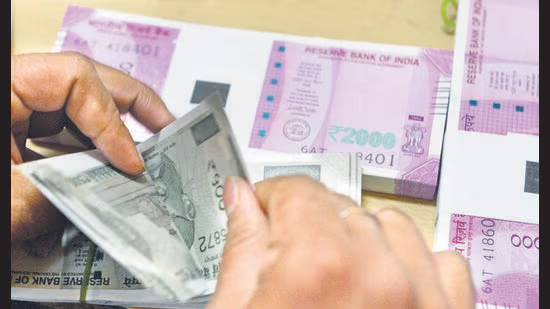- Courses
- GS Full Course 1 Year
- GS Full Course 2 Year
- GS Full Course 3 Year
- GS Full Course Till Selection
- Answer Alpha: Mains 2025 Mentorship
- MEP (Mains Enrichment Programme) Data, Facts
- Essay Target – 150+ Marks
- Online Program
- GS Recorded Course
- Polity
- Geography
- Economy
- Ancient, Medieval and Art & Culture AMAC
- Modern India, Post Independence & World History
- Environment
- Governance
- Science & Technology
- International Relations and Internal Security
- Disaster Management
- Ethics
- NCERT Current Affairs
- Indian Society and Social Issue
- NCERT- Science and Technology
- NCERT - Geography
- NCERT - Ancient History
- NCERT- World History
- NCERT Modern History
- CSAT
- 5 LAYERED ARJUNA Mentorship
- Public Administration Optional
- ABOUT US
- OUR TOPPERS
- TEST SERIES
- FREE STUDY MATERIAL
- VIDEOS
- CONTACT US
PM Approves Constitution of the 8th Pay Commission for Central Government Employees
PM Approves Constitution of the 8th Pay Commission for Central Government Employees

- The Union government approved the establishment of the 8th Pay Commission on January 16, 2025, just days ahead of the Delhi Assembly elections.
What is a Pay Commission?
|
Function of Pay Commission |
|
|
Oversight |
Comes under the Department of Expenditure (Ministry of Finance). |
|
Constitution Frequency |
Constituted every 10 years. |
|
First Pay Commission |
Set up in 1946. |
|
Total Pay Commissions |
7 Pay Commissions have been formed since Independence. |
|
Most Recent Pay Commission |
The 7th Pay Commission was set up in 2014. |
|
Implementation of Recommendations |
7th Pay Commission recommendations were implemented in 2016. |
|
Government's Discretion |
|
Key Points of 8th Pay Commission for Central Government Employees
Target Group
- The Pay Commission will impact approximately 50 lakh serving employees and 65 lakh pensioners of the Union government, including retired defence personnel.
- In Delhi, about 4 lakh employees of the Union government will be affected.
Purpose of the Pay Commission
- The primary objective of the commission is to revise the salaries, pensions, and allowances of central government employees.
- It is also expected to provide wage settlement frameworks for public sector undertakings (PSUs) and state governments, ensuring that similar wage revisions can be implemented across different government bodies.
Key Decisions and Information
- Approval by Prime Minister: The decision to form the Eighth Pay Commission was taken by Prime Minister Narendra Modi, who made the announcement following a Cabinet meeting on January 16, 2025.
-
Appointment of Commission Members:
- The Chairperson and 2 members of the 8th Pay Commission will be appointed soon.
- As per past practices, a retired Supreme Court judge typically heads the commission.
- The 7th Pay Commission, which concluded in 2016, was headed by Justice A.K. Mathur.
-
History of Pay Commissions:
- Since 1947, the Indian government has formed 7 Pay Commissions, with the Seventh Pay Commission implemented in 2016.
- The 7th Pay Commission's term officially ends in 2026.
- However, the decision to establish the Eighth Pay Commission in 2025 ensures that there is enough time for its recommendations to be reviewed before the term of the 7th Commission concludes.
-
Cost of Implementation of Seventh Pay Commission:
- The Seventh Pay Commission led to an expenditure of ₹1 lakh crore in its first year (2016-17) for the government to implement the new pay scales.
Expected Outcomes of the Eighth Pay Commission
-
Wage and Pension Revisions:
- Once the recommendations are accepted, they will serve as the basis for wage settlement in public sector undertakings and state government revisions.
- This is expected to have a significant positive impact on the disposable income of government employees and pensioners, leading to increased consumption and supporting economic growth.
-
Consultation Process:
- The commission will engage in extensive consultations with Union and State governments, as well as other stakeholders, before finalizing its recommendations.
- This will help ensure the fair representation of all sectors and government bodies in the final report.
-
Economic Implications:
- The new pay and pension structure will likely increase the revenue expenditure of the government, as witnessed with the Seventh Pay Commission.
- In 2016-17, following the implementation of the Seventh Pay Commission, the growth in the Government of India’s revenue expenditure rose by 9.9%, compared to 4.8% the previous year.
- D.K. Srivastava, Policy Advisor for Ernst & Young, warned that a similar increase in revenue expenditure in 2026-27 could affect the available fiscal space for the government’s capital expenditure.
Trade Unions' Reactions
-
Welcoming the Decision:
- Various trade unions have welcomed the announcement, noting that the 8th Pay Commission had been a long-standing demand of central government employees.
- General Secretary of the All India Defence Employees Federation, said that employees had been demanding the formation of the commission for over a year.
-
Concerns Over "Living Wage":
- Unions have urged the Pay Commission to review the concept of "living wage".
- Currently, the minimum wage is decided based on a formula designed by Wallace Ruddell Aykroyd, a nutritionist, approved in the 15th Indian Labour Conference of 1957.
The Aykroyd Formula:The formula was designed to ensure that workers could meet basic needs such as food, shelter, and clothing. It was based on the concept of a nutrition-based wage.
Additional Allowances: The minimum wage also included provisions for additional needs, such as healthcare, education, and transportation, though these were less explicitly defined in the formula. |
-
- Union leaders argue that the formula is outdated, as living requirements have drastically changed. Issues raised include the growing cost of internet connectivity, healthcare, and education expenses, which have risen sharply due to privatization.
-
Statements from Other Unions:
- The Bharatiya Mazdoor Sangh (BMS), a trade union supported by the Rashtriya Swayamsevak Sangh (RSS), said that the government’s decision to form the commission reaffirmed its commitment to the welfare of working people.
- The Central Secretariat Service Forum (CSS Forum) also expressed gratitude, calling the move a “progressive step” that reflects the government’s attention to employees' concerns.
Financial and Economic Impact
- Revenue Expenditure Growth: The implementation of new pay scales, such as the one following the Seventh Pay Commission, typically leads to an increase in government revenue expenditure.
- In the first year of the Seventh Pay Commission (2016-17), the government saw a 9.9% increase in revenue expenditure, compared to a much lower 4.8% increase in the previous year.
- Policy Advisor D.K. Srivastava cautioned that such an increase in government expenditure could have a direct impact on the government’s ability to fund its capital expenditures, which are essential for infrastructure and long-term growth.
7th Pay Commission:
When:
Impacted Groups:
|
Key Highlights of 7th Pay Commission:
|
Recommendation |
Details |
|
Minimum Pay |
Entry-level salary: Rs.18,000 per month (from Rs.7,000). Class I Officer salary: Rs.56,100 per month. |
|
Maximum Pay |
Apex Scale: Rs.2.25 lakh per month; Cabinet Secretary level: Rs.2.5 lakh per month. |
|
Pay Matrix |
Replaces the Grade Pay structure; employee status determined by the level in the Pay Matrix. |
|
New Pay Structure |
No new levels introduced; existing levels included in the new structure. |
|
Work-Related Illness and Injury Leave (WRIIL) |
Full pay and allowances for employees hospitalized due to WRIIL. |
|
Fitment Factor |
Uniform Fitment Factor of 2.57 for all employees, with discussions on increasing it to 3.00 times. |
|
Dearness Allowance (DA) |
Recent 2% DA hike benefiting 50 lakh employees and pensioners. Expected further increase of 5%. |
|
Annual Increment |
Retained at 3% annually. |
|
Modified Assured Career Progression (MACP) |
Stricter performance benchmarks, including a "Very Good" level for promotion eligibility. |
|
Military Service Pay (MSP) |
MSP recommended for all defense personnel, including Brigadiers. |
|
Allowances |
196 allowances reviewed; 51 abolished and 37 retained. |
|
House Rent Allowance (HRA) |
HRA increased by 24%, with further increases when DA crosses 50% and 100%. |
|
Advances |
Non-interest-bearing advances abolished, except for PC and House Building Advances. House Building Advance increased from Rs.7.5 lakh to Rs.25 lakh. |
|
CGEGIS |
Increased deductions and insurance amounts for employees. |
|
Medical Changes |
Health Insurance Scheme for employees and pensioners. Cashless medical benefits for pensioners outside CGHS area. |
|
Pension |
New pension formula for pre-2016 retirees based on 50% of last drawn salary with annual increments of 3%. |
|
Gratuity |
Gratuity ceiling raised from Rs.10 lakh to Rs.20 lakh. Potential for a 25% increase when DA crosses 50%. |
|
Disability Pension for Armed Forces |
Shift from percentile-based to slab-based system for disability pensions. |
|
Also Read |
|
UPSC Foundation Course |
UPSC Daily Current Affairs |
UPSC Monthly Mgazine |
CSAT Foundation Course |
Free MCQs for UPSC Prelims |
UPSC Test Series |
ENSURE IAS NOTES |
Our Booklist |




